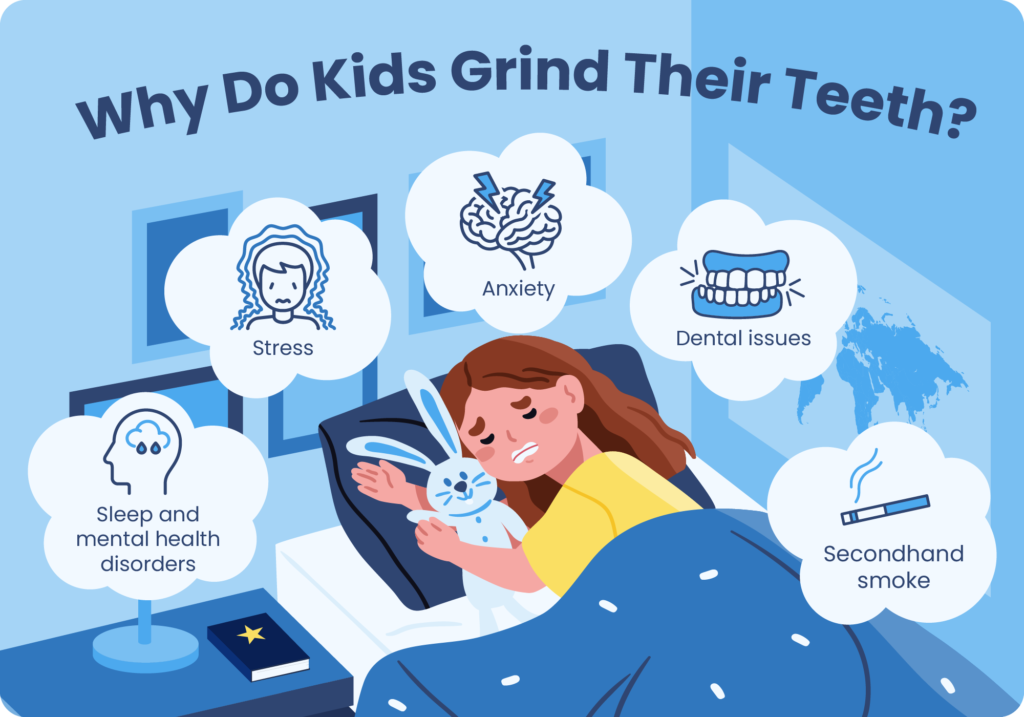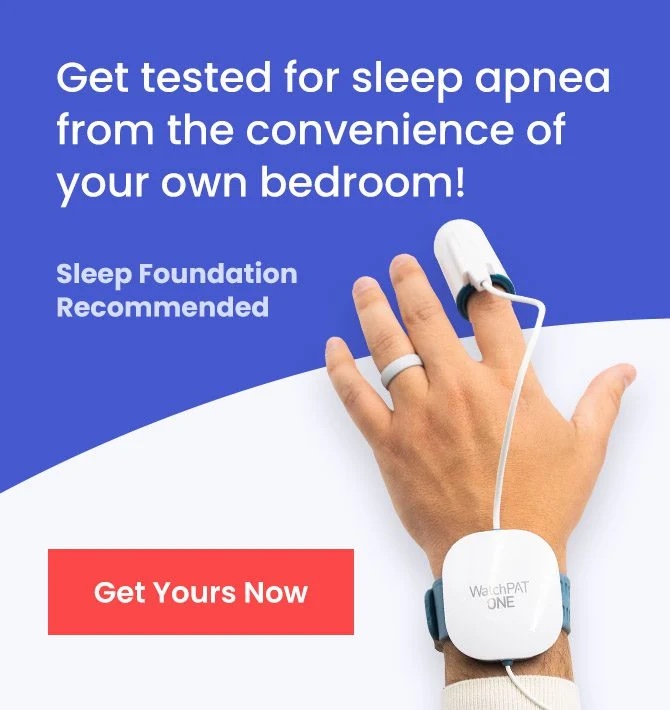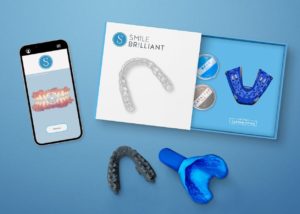When you buy through our links, we may earn a commission. Products or services may be offered by an affiliated entity. Learn more.
Teeth Grinding in Children
It is natural to be concerned if you notice your child grinding their teeth in their sleep. This is called sleep bruxism. Grinding or clenching teeth may be an involuntary response to stress and anxiety. During sleep, adults and children may engage in teeth grinding without being fully aware they are doing it.
Bruxism is not considered dangerous in and of itself, but the constant grinding or clenching of teeth can cause jaw pain and damage to the teeth over time. We examine the causes and risks of sleep bruxism in children and discuss some strategies to prevent this nighttime habit.
What Is Bruxism?
Bruxism is the repetitive grinding or clenching of teeth. There are two distinct types of bruxism: sleep bruxism and waking bruxism. Waking bruxism is believed to be more common and usually consists primarily of teeth clenching without grinding.
Studies estimate anywhere from 6% up to almost 50% of children engage in bruxism during the night. Bruxism is believed to be more common in childhood and can start as soon as the teeth grow in during infancy. More than 80% of people with sleep bruxism may not realize they grind their teeth during sleep. It may be difficult to identify sleep bruxism in children unless they share a bedroom with a sibling or a caregiver. The sounds produced by grinding and clenching teeth may also lead to sleep disruptions for your child or others in the bedroom.
Bruxism can increase the risk of developing:
- Fractured teeth, receding gums, and other problems in the teeth and jaw
- Temporomandibular joint disorder (TMJ)
- Eating disorders
- Mental health disorders such as depression and anxiety
- Sleep problems
Why Do Kids Grind Their Teeth?
Bruxism in children and toddlers likely occurs due to a combination of psychological factors, family history, and environmental triggers. The condition runs in families, though it is not yet clear whether this is due to genetics or additional factors such as similar upbringings. Studies have also found that male children are more likely to engage in bruxism , although more research needs to be conducted to confirm this. People who are predisposed to bruxism may be triggered by one or more additional factors, such as stress or secondhand smoke.

Stress
Stress appears to be closely linked to sleep bruxism, though more research is needed to determine whether stress causes bruxism or vice versa. For school-age children, bruxism may be a way of coping with the stress of homework, chores, and getting good grades.
Researchers have found higher levels of self-reported stress as well as stress-related hormones in people with sleep bruxism, though additional studies have failed to replicate these findings.
Age
Children ages 7 to 10 are most likely to engage in sleep bruxism, but the condition is seen in children of all age groups.
- Infants: Babies can experience bruxism as soon as their teeth come in, and has been reported in children 1 year and under. Infants may engage in bruxism to soothe discomfort associated with teething. Chronic oral habits like teeth grinding during infancy typically do not cause long-term health complications, but may cause infants to cease breastfeeding prematurely.
- Toddlers: Research suggests stress and separation anxiety may trigger episodes of sleep bruxism in toddlers and children. It is unlikely for teeth grinding during infancy and toddlerhood to affect the structural integrity of adult teeth.
- School-age children: Teeth grinding may emerge or reemerge in children who are shedding their baby teeth and growing in their permanent set. Research also suggests that children may unconsciously release daytime tension and stress through nighttime teeth grinding.
Anxiety
Though research is inconclusive , there is some evidence of a link between anxiety levels and sleep bruxism in children. Children who are naturally restless and who worry more about doing well in school appear more likely to engage in bruxism.
Researchers note that symptoms may evolve over time as children develop, which may be why the connection is not evident at first glance. For example, toddlers who experience more severe separation anxiety are more likely to develop sleep bruxism in elementary school.
Other Sleep and Mental Health Disorders
Along with stress and anxiety, bruxism seems to occur more in children with certain other conditions, such as migraines or attention deficit hyperactivity disorder (ADHD) . However, it is unclear whether bruxism is caused by ADHD or commonly prescribed medications used to manage ADHD symptoms, including some stimulants.
In addition, children and adolescents with neurodevelopmental disorders or autism spectrum disorder may experience both waking and sleep-related bruxism. Bruxism can also go hand in hand with sleep disturbances, including parasomnias, snoring, and sleep-related breathing disorders. However, it is difficult to say whether these are a cause or an effect of teeth grinding at night.
Dental Issues
Bruxism is more common in children with misaligned teeth and those who wear fixed orthodontic appliances like braces. However, according to the American Academy of Sleep Medicine, there is not enough evidence to identify dental issues as a cause of bruxism. Bruxism is also more common in people who breathe primarily through their mouth .
Secondhand Smoke
Secondhand smoke is another risk factor for developing bruxism in childhood. Research suggests that even moderate exposure to secondhand smoke increases the risk of bruxism in children.

Signs Your Child May Be Grinding Their Teeth at Night
Some common symptoms and signs your child may be experiencing teeth grinding during the night include:
- Tooth damage: Children with sleep bruxism may experience dental fractures, wearing down of the teeth, or receding gums.
- Sensitive teeth: Children who grind their teeth may be more sensitive to hot or cold food and drinks.
- Jaw pain or headaches: Constant pressure from clenched teeth may result in headaches, jaw pain, and occasionally clicking sounds or increased size of the jaw muscles.
- Grinding sounds: Children can be observed during the night to check for grinding noises. To avoid disturbing a child’s sleep, opt for a baby monitor to watch for signs of sleep bruxism.
Diagnosing Bruxism in Children
To be diagnosed with bruxism, your child must show tooth grinding sounds while asleep, coupled with corresponding tooth wear, morning jaw pain, headaches, and/or a locking jaw. These signs may be noticed by a dentist during a routine appointment, or they may be identified by a doctor if your child complains of morning pain or poor sleep. Since sleep bruxism occurs during the night, dentists rely heavily on parent reports of grinding or clenching noises during the child’s sleep.
Your child’s care provider may ask about current stressors to obtain a fuller picture of potential precipitating factors. More rarely, they may refer your child for polysomnography, an overnight sleep exam, to check for signs of bruxism or other sleep disorders.
Treatments for Bruxism
Bruxism treatment focuses on preventing tooth damage and reducing side effects such as pain and headaches. Improving sleep quality and addressing sources of stress may help make bruxism more manageable.
Nightguards
A dentist can help fit your child with a night guard or splint to protect their teeth while they sleep. The splint may fit over the top or bottom teeth, and may be designed to reposition the jaw in addition to shielding the teeth from friction. Night guards and splints appear to be effective at treating bruxism , although the bruxism may not fully go away and symptoms may return if your child does not use the guard.
Stress Relief
Managing stress can help reduce teeth grinding. Talk to your child about what may be occuring in their life that is causing them distress, such as a recent move or academic obligations. If necessary, reach out to a mental health professional or your child’s school counselor for additional support.
Sleep Hygiene and Bedtime Routine
Sleep bruxism is closely tied to sleep quality. You can improve your child’s sleep by ensuring their room is dark and quiet, limiting the time they spend using electronic media, and providing them with a nutritious diet low in added sugars.
Establishing a bedtime routine can set the stage for healthy sleep and help your child feel confident and secure at bedtime. Some examples of soothing bedtime activities are:
- Eating a nutritious snack before bed
- Brushing teeth
- Taking a warm bath
- Cuddling together with your child
- Reading stories
- Singing or soft music
Symptom Relief
Working on relaxing the face muscles during the day can sometimes reduce nighttime bruxism. To soothe painful jaws and teeth, use a cold or hot compress, encourage your child to drink water and avoid hard foods and chewing gum. Ask your doctor about stretching exercises and facial massage techniques.
Medication
There is some evidence that homeopathic remedies or medication may help reduce sleep bruxism in children, but more research is needed to evaluate the efficacy and possible side effects. Always talk to your doctor before starting any new medication, even if it is marketed as natural or sold over the counter. As bruxism is not considered harmful apart from its secondary effects on the teeth and jaw, your child’s doctor should weigh whether taking medication is worth the potential side effects.
When to Talk to Your Doctor or Dentist
Talk to your dentist or pediatrician if you notice symptoms of bruxism in your child, such as heightened mouth sensitivity, jaw pain, morning headaches, or grinding noises during the night or during naps. You should also consult a health care provider if your child is having trouble sleeping or showing signs of sleepiness during the day.

Still have questions? Ask our community!
Join our Sleep Care Community — a trusted hub of sleep health professionals, product specialists, and people just like you. Whether you need expert sleep advice for your insomnia or you’re searching for the perfect mattress, we’ve got you covered. Get personalized guidance from the experts who know sleep best.
References
15 Sources
-
Machado, E., Dal-Fabbro, C., Cunali, P. A., & Kaizer, O. B. (2014). Prevalence of sleep bruxism in children: A systematic review. Dental Press Journal of Orthodontics, 19(6), 54–61.
https://pubmed.ncbi.nlm.nih.gov/25628080/ -
American Academy of Sleep Medicine. (2014). The International Classification of Sleep Disorders – Third Edition (ICSD-3). Darien, IL.
https://aasm.org/ -
Guo, H., Wang, T., Niu, X., Wang, H., Yang, W., Qiu, J., & Yang, L. (2018). The risk factors related to bruxism in children: A systematic review and meta-analysis. Archives of Oral Biology, 86, 18–34.
https://pubmed.ncbi.nlm.nih.gov/29149621/ -
Karakoulaki, S., Tortopidis, D., Andreadis, D., & Koidis, P. (2015). Relationship between sleep bruxism and stress determined by saliva biomarkers. The International Journal of Prosthodontics, 28(5), 467–474.
https://pubmed.ncbi.nlm.nih.gov/26340005/ -
Nowak, A. J., & Warren, J. J. (2022, July 18). Oral habits and orofacial development in children. In A. Griffen. (Ed.)., Retrieved November 2, 2022, from
https://www.uptodate.com/contents/oral-habits-and-orofacial-development-in-children\ -
Garmroudinezhad, R. E., Touchette, É., Huynh, N., Montplaisir, J., Tremblay, R. E., & Battaglia, M., Boivin, M. (2020). High separation anxiety trajectory in early childhood is a risk factor for sleep bruxism at age 7. Sleep, 43(7).
https://pubmed.ncbi.nlm.nih.gov/31894243/ -
Alfano, C. A., Bower, J. L., & Meers, J. M. (2018). Polysomnography-detected bruxism in children is associated with somatic complaints but not anxiety. Journal of Clinical Sleep Medicine, 14(1), 23–29.
https://pubmed.ncbi.nlm.nih.gov/29198292/ -
Masuko, A. H., Villa, T. R., Pradella-Hallinan, M., Moszczynski, A. J., Carvalho, D., Tufik, S., do Prado, G. F., & Coelho, F. M. (2014). Prevalence of bruxism in children with episodic migraine–a case-control study with polysomnography. BMC Research Notes, 7, 298.
https://pubmed.ncbi.nlm.nih.gov/24886343/ -
Kuhn, M., & Türp, J. C. (2018). Risk factors for bruxism. Swiss Dental Journal, 128(2), 118–124.
https://pubmed.ncbi.nlm.nih.gov/29533049/ -
Morse, A. M., & Kotagal, S. (2021, November 8). Sleep-related movement disorders in childhood. In R. D. Chervin. (Ed.)., Retrieved November 2, 2022, from
https://www.uptodate.com/contents/sleep-related-movement-disorders-in-childhood -
Ribeiro-Lages, M. B., Martins, M. L., Magno, M. B., Masterson Ferreira, D., Tavares-Silva, C. M., Fonseca-Gonçalves, A., Serra-Negra, J. M., & Maia, L. C. (2020). Is there association between dental malocclusion and bruxism? A systematic review and meta-analysis. Journal of Oral Rehabilitation, 47(10), 1304–1318.
https://pubmed.ncbi.nlm.nih.gov/32246486/ -
Prado, I. M., Abreu, L. G., Silveira, K. S., Auad, S. M., Paiva, S. M., Manfredini, D., & Serra-Negra, J. M. (2018). Study of associated factors with probable sleep bruxism among adolescents. Journal of Clinical Sleep Medicine, 14(8), 1369–1376.
https://pubmed.ncbi.nlm.nih.gov/30092895/ -
Lamenha Lins, R. M., Cavalcanti Campêlo, M. C., Mello Figueiredo, L., Vilela Heimer, M., & Dos Santos-Junior, V. E. (2020). Probable sleep bruxism in children and its relationship with harmful oral habits, type of crossbite and oral breathing. The Journal of Clinical Pediatric Dentistry, 44(1), 66–69.
https://pubmed.ncbi.nlm.nih.gov/31995421/ -
Montaldo, L., Montaldo, P., Caredda, E., & D’Arco, A. (2012). Association between exposure to secondhand smoke and sleep bruxism in children: A randomised control study. Tobacco Control, 21(4), 392–395.
https://pubmed.ncbi.nlm.nih.gov/22246780/ -
Chisini, L. A., San Martin, A. S., Cademartori, M. G., Boscato, N., Correa, M. B., & Goettems, M. L. (2020). Interventions to reduce bruxism in children and adolescents: A systematic scoping review and critical reflection. European Journal of Pediatrics, 179(2), 177–189.
https://pubmed.ncbi.nlm.nih.gov/31858254/






